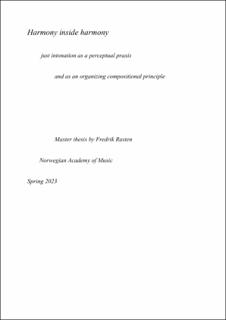| dc.description.abstract | Abstract -
This research looks at how the combined knowledge of structure and perception of just intonation (JI) can work together with other musical approaches to organize musical material for compositions, both for solo guitar and for ensembles. The research has three main goals. First, it aims at showing the interconnectedness of JI theory and perception, and how both are manifestations of the structure of JI. Second, the research aims to document and present personalized methods of approaching the guitar in the context of JI music. Finally, it aims to establish the case that JI music involves a unique mode of listening that in its ideal form is shared between listeners and musicians when such material is performed. Introducing my research, Chapter 1 and 2 cover the overarching elements and the context of the research. The succeeding three chapters (3, 4 and 5) comprise the main body of the text. Chapter 3 is purely theoretical, where key aspects of JI are illuminated in their own terms. Chapter 4 discusses case studies, where musical pieces are analyzed through their JI elements – theoretically, perceptually and practically. In Chapter 5 I argue for the existence of a unique mode of listening shared between performers and listeners when JI music is realized. Finally, the brief, concluding Chapter 6 concerns the results of my research and its implications for future research and praxis. The main research materials are four of my own compositions serving as case studies, two of which are analyzed comparatively with works by composers Catherine Lamb and Marc Sabat. Through harmonic analysis of selected sections, the research aims at showing how these pieces exemplify both distinct and shared methods of utilizing JI harmony in composition, and how realizing them are part of a perceptually rooted musical praxis. In the introduction I make a distinction between overarching research methods and musical methods. The research methods both encompass theoretical descriptions of JI concepts, and analysis of JI elements as they occur in musical context drawing on the case studies. Musical methods include ways of composing pieces in JI, where improvisation or open elements are implemented. | en_US |
